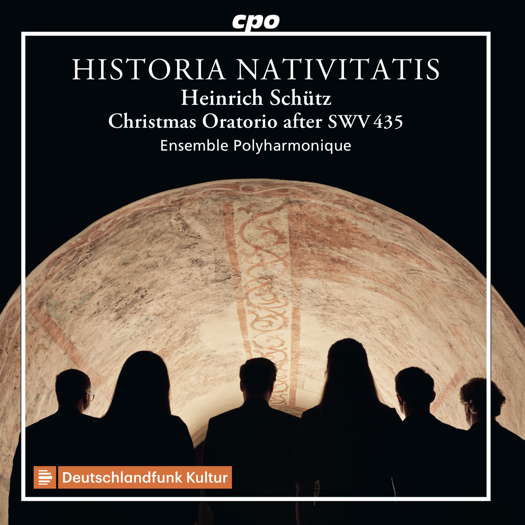- MusiContact GmbH
- waltz music
- Bliss
- Strauss: Metamorphosen
- Daniel Pelton Collective
- Daniel Schorno
- Intermusica
- Saint Louis
 SPONSORED: CD Spotlight. Well Realized - Varda Kotler and Israel Kastoriano - recommended by Geoff Pearce.
SPONSORED: CD Spotlight. Well Realized - Varda Kotler and Israel Kastoriano - recommended by Geoff Pearce.
All sponsored features >>
 DISCUSSION: What is a work? John Dante Prevedini leads a discussion about The performing artist as co-creator, including contributions from Halida Dinova, Yekaterina Lebedeva, Béla Hartmann, David Arditti and Stephen Francis Vasta.
DISCUSSION: What is a work? John Dante Prevedini leads a discussion about The performing artist as co-creator, including contributions from Halida Dinova, Yekaterina Lebedeva, Béla Hartmann, David Arditti and Stephen Francis Vasta.

The Selflessness of Schütz
JOHN DANTE PREVEDINI listens to music by Heinrich Schütz and some of his contemporaries
'... a deeply satisfying listening experience ...'
Historia Nativitatis: A Christmas Oratorio after Heinrich Schütz SWV 435 is the recent CPO-label release by Ensemble Polyharmonique of a nontraditional, though historically informed, performance of the Schütz work SWV 435. The two-CD set, which is also available as a digital release, includes a booklet containing extensive historical liner notes in English and German with illustrative recording session photographs. This unusual album highlights an aspect of early compositional thinking which nonetheless seems to receive surprisingly little representation in present-day performances of early music. SWV 435 is a work also known as the Weihnachtshistorie, or - in English - Christmas Story; it is essentially an early oratorio consisting of 'Evangelist' recitatives interspersed with intermedia (solos, trios, choruses, etc), composed for the court of Dresden and partially published in 1664. The genesis of the present Ensemble Polyharmonique recording stems from a notable specification in Schütz's preface: that his own intermedia may be substituted using settings of the same texts by other composers, including newly composed music. Ensemble Polyharmonique have thus responded to Schütz's challenge by imagining what such an interpretation of the Weihnachtshistorie might have sounded like in his own time and place, using a variety of Christmas text settings that would have possibly been available to court ensembles in what is now central Germany during the later seventeenth century.
Since Beethoven, it has become habitual in the Western classical music tradition to think of composers primarily as artists with individual aesthetic intentions needing to be revered, channeled and expressed by future conductors and ensembles. It is, thus, easy to forget that composers in earlier eras were primarily called to be facilitators of immediate musical events - skilled craftspeople in public service whose regular duties revolved around practical civic and liturgical functions. Indeed, it is apparent from the SWV 435 preface that Schütz saw his own role in this same humble light, putting the technical and social requirements of the performance itself above any material allegiance to his particular aesthetic. In this way, the album expands the meaning of 'historically informed performance' by introducing a rare example of historically informed realization of compositional intent. This is an aspect of early compositional thinking and performance practice that seems to have no modern equivalent in the Western classical world and which I have rarely, if ever, seen recreated - even within early music circles.
Listen — Andreas Hammerschmidt: O ihr lieben Hirten fürchtet euch nicht
(cpo 555 432–2 CD1 track 11, 1:20-1:50) ℗ 2022 Classic Produktion Osnabrück :
To those like myself who have long known SWV 435 and have heard many 'traditional' recordings of it, this album will likely feel both familiar and surprising. While the Evangelist's recitatives and one of the intermedia, 'Ehre sei Gott in der Höhe', are from Schütz's original setting of the Christmas story, the rest of the items are almost all from settings by other composers. There are two exceptions, and these are excerpts from older works by Schütz that predate SWV 435 while using similar or related texts. The album also opens with a 'prologue' of six selections from various composers that set the tone for the dramatic structure of the Christmas story that will follow.
Listen — Schütz: Ehre sei Gott in der Höhe
(cpo 555 432–2 CD1 track 13, 0:15-0:47) ℗ 2022 Classic Produktion Osnabrück :
This makes for an overall listening experience of about eighty-four minutes in which we hear the works of fifteen different composers, some of whom may be more familiar than others: Andreas Hammerschmidt, Tobias Michael, Johann Eccard, Melchior Franck, Johann Rosenmüller, Sethus Calvisius, Stephan Otto, Michael Praetorius, Samuel Scheidt, Phillip Dulichius, Johann Herrman Schein, Johann Georg Carl, Bartholomäus Gesius, Wolfgang Carl Briegel and Schütz himself. Among the various items presented are two familiar seasonal offerings likely to appeal to more general audiences: the famous Praetorius 'Es ist ein Ros entsprungen' and a closing 'In dulci jubilo' setting by Scheidt.
Listen — Samuel Scheidt: Hirtengesang - Psallite unigenito
(cpo 555 432–2 CD1 track 19, 0:22-0:52) ℗ 2022 Classic Produktion Osnabrück :
Considering the vast array of compositional voices present on this album, it is remarkable the degree to which the overall result seems faithful to the emotional intentions of Schütz's original settings of the texts for SWV 435, especially since so many movements have been substituted using selections from other composers. Two examples I will give of this are the Otto setting of 'Lasset uns nun gehen' and the Carl setting of 'Ziehet hin', both of which seem strikingly similar in tone and structure to the original ones by Schütz. In addition to this, the ensemble demonstrates remarkable care and attention to detail regarding all other parameters of the recording, including well-judged tempos and phrasing, thoughtfully chosen and sequenced repertoire and a remarkable sonic balance that includes the brilliant addition of a harp to the ensemble's continuo. This helps unify these brief examples from various compositional voices into a seamless musical event that hardly feels like the pastiche one might expect to result from such an effort.
Listen — Johann Georg Carl: Zu Bethlehem im jüdischen Lande
(cpo 555 432–2 CD2 track 7, 0:28-0:58) ℗ 2022 Classic Produktion Osnabrück :
In conclusion, I consider this release to be a major victory for three reasons: it is a deeply satisfying listening experience, it introduces a diverse range of seventeenth-century German composers under a single cohesive musical event and, perhaps most notably, it productively challenges the way in which historical compositional thinking is habitually portrayed in 'historically informed performance' contexts. Furthermore, it is an explicit call by Ensemble Polyharmonique for other ensembles to propose their own solutions to Schütz's selfless creative challenge in SWV 435. The poignant fact here is that Schütz's invitation for collaboration still remains open to us, even now. There is nothing to say that newly-composed Weihnachtshistorie music from the twenty-first century would not fulfill Schütz's compositional intent as expressed in 1664. It thus leaves open the possibility for an SWV 435 interpretation that pairs Schütz's original recitatives with completely new intermedia or, alternatively, with thematically compatible music from many different centuries compiled into a single performance to tell the Christmas story. I look forward to seeing what other like-minded interpretations are possible for SWV 435 or, indeed, for any other examples of early music whose composers express a similar intent of collaborative openness unbounded by time and place.
Copyright © 7 March 2022
John Dante Prevedini,
Connecticut, USA

CD INFORMATION: HISTORIA NATIVITATIS
ARTICLES ABOUT CHRISTMAS MUSIC
CLASSICAL MUSIC ARTICLES ABOUT GERMANY
RECENT CLASSICAL MUSIC CD REVIEWS


